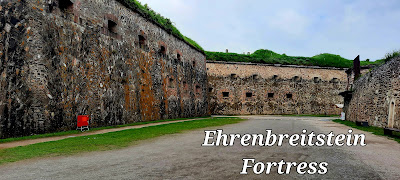Today's blog takes us to the next port on the Rhine River. the city of Koblenz, Germany and a disappointing Fortress that was an outside-only tour in frigid weather. That day in May it was only near 48F/8.89 C with wind chills in the upper 30s (around 2.7 C). Sweatshirts in May with that kind of cold didn't make for a comfortable outside tour. Regardless, today's blog will highlight the fortress, and a gondola ride, and tell you about Koblenz.
(Photo: Rob and Tom, freezing in the outdoor tour of the Fortress in Koblenz, Germany. Credit: R.G.)ABOUT KOBLENZ - Koblenz is a German city on the banks of the Rhine and the Moselle, a multinational tributary. Koblenz was established as a Roman military post by Drusus around 8 B.C. Its name originates from the Latin cōnfluentēs, meaning " confluence." The population is 114,024. In World War 2, up to 80 percent of the city was destroyed and had to be rebuilt.
EHRENBREITSTEIN FORTRESS - Ehrenbreitstein Fortress is a huge stone-built complex located high on a hill that overlooks the confluence of the Rhine and Moselle River.
HISTORY OF THE FORT - The location was settled as far back as the 4th Century B.C. and a Roman fort existed there between 400-500 A.D. Construction on the current fortifications began around 1100 A.D. In 1801, the fort was partially destroyed by Napoleon and the French took possession of it for about 18 years.
WHO BUILT UP THE CURRENT STRUCTURE? - Between 1817 and 1828, Ehrenbreitstein was built up by the Prussians.
(Photo: Entrance to the fortress. Credit: R.G.)
USE OR NON-USE - It was really a storage place. After January 1923, Ehrenbreitstein was occupied by the French Army. During World War II, the fortress served as a place of safekeeping for archives and cultural objects (1943–56) but also harbored three flak guns (1943–1945).
OUR EXPERIENCE - We had to take a bus to the top of the hill and when we got to the fortress we were greeted by an actor with a good sense of humor, who led the group of 20 or so on a frigid walk around the outside of the fortress. The weather was BITTER cold. What's more irritating was that we learned that we were not allowed to go inside the rooms of the fort (to see how people lived or worked in it), ONLY to walk around the outside for over an hour or two. It was so uncomfortable that we couldn't wait for it to be over.VIDEO TOUR: I found this unnarrated video view of the fortress online. It was created by . WATCH: https://youtu.be/HcnhbRGnRSk







No comments:
Post a Comment